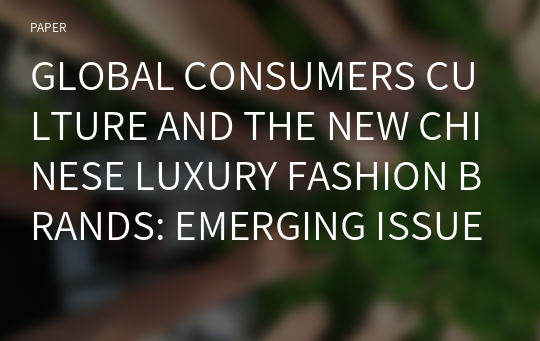GLOBAL CONSUMERS CULTURE AND THE NEW CHINESE LUXURY FASHION BRANDS: EMERGING ISSUES AND NEW TRENDS FROM THE LOCAL “CHINA BRANDSCAPE”
* 본 문서는 배포용으로 복사 및 편집이 불가합니다.
서지정보
ㆍ발행기관 : 글로벌지식마케팅경영학회(GFMC)
ㆍ수록지정보 : GFMC Session1
ㆍ저자명 : Serena ROVAI
ㆍ저자명 : Serena ROVAI
영어 초록
It is certainly not possible to analyse the evolution of the global luxury consumers orientations for the new luxury Chinese brands without considering the essence and the impact of the “brandscape”. In the last decade, China has assisted to the surge of the “luxury lifestyle” for a multiplicity of consumer segments living in those coastal areas – and not only - filled with luxury and fashion brands, that invaded every city area from streets to airports from clinics to hotels where concept stores, luxury flagship stores, sponsorships for events and urban artefacts “add value to the symbolic production of an urban lived space” (Bellini and Pasquinelli, 2015). Luxury product brands are enriched by the synergy with the city brand and the diverse fashion and art city locations, activities and events. In the new luxury perspective that sees luxury in its experiential dimension and no longer only in desire of an exclusive object, the relation of luxury brands and city brand requires a specific focus, in particular in the new fast growing economies as China that sees the rise of the new experiential luxury lifestyle and new local luxury brands. In the fast growing luxury Chinese luxury market where new Chinese luxury brands are striving to acquire a brand identity and image first in the local market and then in the international one, city branding may be a conductive solutions for brand value and identity creation. Authentic luxury experiences in significant city contexts appear added value activities for luxury brands in particular for those with no consolidated heritage and identity as the new Chinese luxury brands. New retail formats such as pop-up stores, concept stores located in specific high value artistic or fashion related locations adds value (Bellaiche et al, 2012). For Chinese luxury brands with a very limited identity, a almost absent heritage and a ongoing value creation of the brand, in-store experience is increasingly important (Atsmon et al, 2012) and the shopping location certainly represent an important factor for the increasingly diverse and demanding luxury customers by being not only the instrument towards the desired subjects but also a value-adding experience on its own (Rintamaki et al, 2007, p. 628). The emergence of the Chinese luxury consumer did not mean the presence on a market where the consumers are gathered by the same tastes, desires and purchasing patterns. Reference to the global consumer culture and paradigm evidenced that consumers in diverse geographical contexts may have different and sometimes even conflicting opinions or shared desires and values expressed in similar behaviours or symbols towards a brand. Global brands sets the international standards and convey shared symbols (Holt, Quelch and Taylor 2004) and a myth of cosmopolitanism to which many consumers world-wide appreciate (Strizhacova, Coulter and Price 2008).Brands represent a form of culture and they relate to the way people live, think, eat and choose to wear as well, a form of seeing life and the world (Askegaard, Kjeldgaard and Arnould, 2009) . Luxury brands have become increasingly present in the Chinese consumer market and lifestyle and the role of purchasing luxury goods experiencing a luxury lifestyle has taken an unexpected importance and meaning in the Chinese social context. China has started to experience the consumer culture only after China's opening up to the market economy as a result of the economic reforms post-1979 that have given to "aspirational" consumers more freedom to develop a consumer culture partially away from political limitations but still permeated in the Chinese culture and its characteristics. Those reforms have also given rise to the private businesses and the birth of a consumer middle class, "the new rich", in China. The birth of the Chinese middle class has fuelled the emergence of a highly diversified consumer class with different purchasing attitudes (Latham, 2006) and a new way to express their taste, their motivation for purchasing (Gillette, 2000) and in particular an increasing brand awareness, mode of purchasing and conceptualisation of luxury (Rambourg, 2014; Rovai, 2016). Distinctive aspects of luxury consumer culture have started to emerge in the late years, evidencing new desires for Chinese luxury consumers with respect to luxury brands, accompanied by the entrance in the market of Chinese luxury brands aspiring the capitalise on the increasing "Chinese luxury desire" but limited by their lack of specific characteristics of authentic luxury brands - heritage, identity and prestige amongst others. As a result, this research focuses on the analysis of Chinese luxury brands presence in the local Chinese urban context; specifically, it focuses on how the Chinese urban fashion context can help to support the creation of a luxury brand value and also reinforce a luxury brand identity and image in a Chinese luxury consumer culture that does not possess a luxury heritage. An analysis of two luxury Chinese brands and a local luxury and fashion concept store has been initiated together with further evidence from the Shanghai urban context, its activities, events and cultural specifics together with the following a qualitative method and in particular Yin (1989) case study approach. A series of 15 interviews have been held in late 2016 in Shanghai with the two Chinese luxury brands creative designers, owners and staff during one month together with observation and consulting of documents. Literature review has focused on the role of individual brands that, being somehow associated with the city become a collective brand (Pasquinelli, 2014), framing "the complex network of associations, linking products, spaces, organizations and people (Bellini and Pasquinelli, 2015). Initially, an important attention has been oriented towards the geographical associations to the country-of-origin effect (Bilkey and Nes, 1982; Johansson et al, 1985) later on evidencing that a defragmentation into of smaller geographical units may be appropriate at urban level (Bellini and Pasquinelli, 2015) to highlight the relevance of the "origin" not simply in relation to a broad geographical context where the brand manufactures a product but also „the place, region or country where a brand is perceived to belong‟ (Thakor and Kohli, 1996, p. 26). The origin being not only a matter of product production but more of product conceptualisation, perception or consumption going towards the "brand product usage context" (Gerr et al, 1999). Brand product usage happen in those spatial circuits whose cities are part of and whose role may be conductive to the „local origination‟ of product brands, adding value to the birth and internationalisation of locally originated brands (Pike, 2011). Those local brands are developed from an ecosystem composed by relations and ownerships involving a multiplicity of stakeholders whose customers are an integral part (Power and Hauge, 2008). In the literature, Fashion capitals is a unique case of those ecosystems with a specific relationship between industry and spacial circuits is based on the urban context instrumental to fashion creation and also to consumption (Breward and Gilbert, 2006). The city as a part of the consumer culture and in particular as part of the brand product experience (Thrift, 2004). As a result of the literature review and the conceptualisation of fashion capitals as ecosystems conductive to the fashion creation and consumption, an exploratory study of: Which context related variables affect new Chinese luxury brands identity and value and how the China fashion capital ecosystem affects Chinese luxury consumers brand perception. The paper will show an insight of the instrumental relation of the "brandscape" Shanghai and the impact on the Chinese luxury brands value and identity acquisition with respect to Chinese consumers.참고 자료
없음"GFMC Session1"의 다른 논문
 FAST AND SLOW FASHION BRANDS IN DEVELOPING SUSTAINABLE ..6페이지
FAST AND SLOW FASHION BRANDS IN DEVELOPING SUSTAINABLE ..6페이지 “WHAT IF A CELEBRITY AND A BRAND CO-CREATE A NEW COLLEC..7페이지
“WHAT IF A CELEBRITY AND A BRAND CO-CREATE A NEW COLLEC..7페이지 THE INSTAGRAM’S STRATEGY IN ENGAGING THE CUSTOMER’S LOY..3페이지
THE INSTAGRAM’S STRATEGY IN ENGAGING THE CUSTOMER’S LOY..3페이지 THE PARTICULARITIES OF NEW PRODUCT DEVELOPMENT IN THE T..5페이지
THE PARTICULARITIES OF NEW PRODUCT DEVELOPMENT IN THE T..5페이지 THE LONE CHOCOLATE BAR: THE INFLUENCE OF PERCEIVED SCAR..6페이지
THE LONE CHOCOLATE BAR: THE INFLUENCE OF PERCEIVED SCAR..6페이지 ADS AS WORKS OF ART: MEASURING ADVERTISING IMMERSION3페이지
ADS AS WORKS OF ART: MEASURING ADVERTISING IMMERSION3페이지 ECONOMIES OF SMALL: NICHE STRATEGIES AND SUCCESS FACTOR..8페이지
ECONOMIES OF SMALL: NICHE STRATEGIES AND SUCCESS FACTOR..8페이지 THE INFLUENCE OF ONLINE CUSTOMER REVIEWS ON RETAILERS' ..6페이지
THE INFLUENCE OF ONLINE CUSTOMER REVIEWS ON RETAILERS' ..6페이지 IS THE ARTIFICATION PROCESS PERCEIVED BY FINAL CONSUMER..6페이지
IS THE ARTIFICATION PROCESS PERCEIVED BY FINAL CONSUMER..6페이지 THE ODD EVEN PRICE PARADOX IN THE FASHION LUXURY SECTOR6페이지
THE ODD EVEN PRICE PARADOX IN THE FASHION LUXURY SECTOR6페이지


























